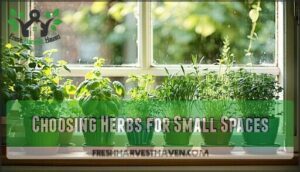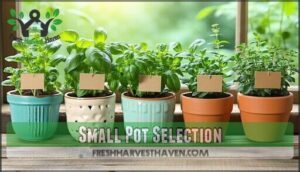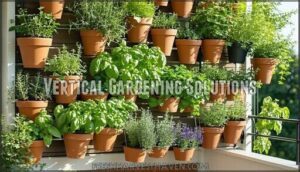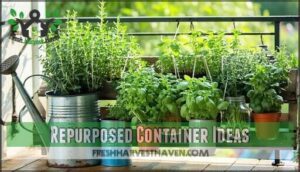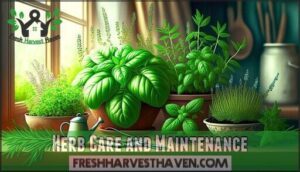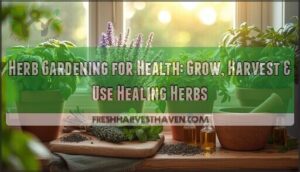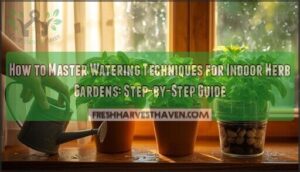This site is supported by our readers. We may earn a commission, at no cost to you, if you purchase through links.

Compact varieties like basil, thyme, and chives thrive in 4-6 inch pots on windowsills or balconies.
These space-savers pack serious flavor punch—basil transforms pasta dishes, while thyme elevates roasted vegetables with just a pinch.
Mint’s aggressive growth habit makes containers your best friend, preventing it from taking over your entire garden like an overeager dinner guest.
Marjoram stays naturally compact, fitting perfectly between other plants.
Most herbs need 4-6 hours of sunlight daily and well-draining soil.
The secret lies in choosing the right varieties and understanding their unique spacing requirements.
Table Of Contents
- Key Takeaways
- Choosing Herbs for Small Spaces
- Container Gardening Options
- Herb Care and Maintenance
- Culinary Uses of Herbs
- Growing Herbs for Health Benefits
- Frequently Asked Questions (FAQs)
- What herbs suit small pots?
- What is the mother of all herbs?
- Which herb will spread quickly and take over a small area?
- Can herbs grow in 4 inch pots?
- Can herbs survive indoors during winter months?
- How long do herb seeds take to germinate?
- What soil type works best for herb containers?
- Should I use organic or synthetic fertilizers?
- Can I grow herbs from grocery store cuttings?
- Conclusion
Key Takeaways
- You can grow flavorful herbs like basil, thyme, and chives in just 4-6 inch pots on windowsills or balconies, proving you don’t need acres of space for a productive herb garden.
- You’ll maximize your limited space by choosing compact varieties and using vertical solutions like wall planters, tiered shelving, or hanging pots that transform any wall into a productive growing area.
- You’ll keep your herbs thriving with proper care—most need 4-6 hours of daily sunlight, well-draining soil, and weekly watering when the top inch of soil feels dry.
- You’ll transform your cooking by pairing herbs strategically (Italian dishes) and preserving them through drying, freezing in oil, or creating herb-infused vinegars.
Choosing Herbs for Small Spaces
When you’re selecting herbs for cramped quarters, focus on compact varieties like basil, thyme, and chives that won’t outgrow their containers or overwhelm your windowsill.
You’ll want to match each herb’s growth pattern and light needs to your available space, since sprawling mint requires different planning than upright-growing cilantro.
Compact Herb Varieties
Several compact herb varieties transform even the tiniest spaces into productive gardens.
Even a windowsill can become your personal herb paradise with the right compact varieties.
You’ll find upright thyme with white flowers takes minimal room compared to sprawling varieties, while Lavandula angustifolia’s compact cultivars fit perfectly in containers.
Rosemary Miss Jessops maintains an upright habit with regular pruning.
These dwarf herbs and miniature herb gardens prove that limited-space herbs don’t compromise on flavor or productivity in container herb gardening setups.
Herb Growth Habits
Understanding each herb’s growth habit helps you maximize your growing space effectively.
Upright growers like basil and thyme fit neatly into narrow containers, while sprawling herbs like mint need wider pots or separate containment.
Root structure matters too—shallow-rooted varieties require less soil depth than deep-rooted herbs.
Compact varieties with controlled spreading patterns work best for tight quarters, preventing one plant from overwhelming others, which is crucial for effective space management and maintaining a healthy balance among herbs.
Climate and Light Requirements
Light needs vary dramatically among small space herbs.
Most culinary varieties demand 6-8 hours of direct sunlight daily, while shade-tolerant options like mint and chives survive with just 4-6 hours.
Your windowsill’s microclimates matter too—south-facing spots maximize light exposure, but east or west windows work for less demanding herbs.
Temperature ranges between 65-75°F keep most herbs happy, though seasonal adjustments help maintain ideal humidity levels year-round, and a consistent temperature is crucial for the herbs’ well-being, making direct sunlight a significant factor.
Container Gardening Options
You’ll find that container gardening transforms any small space into a productive herb haven, whether you’re working with windowsills, balconies, or countertops.
Your choice of containers—from traditional terracotta pots to repurposed mason jars and vertical wall planters—determines how many herbs you can grow and how efficiently you’ll use your available space.
Small Pot Selection
Choosing the right small pots sets your herb garden’s foundation for success. You’ll need containers at least 6 inches deep with proper drainage solutions to prevent waterlogged roots.
Terra cotta and ceramic offer excellent container material options, while plastic works for budget-conscious gardeners.
Match pot size to herb size—compact basil thrives in 8-inch containers, while sprawling mint needs more room.
Decorative containers add aesthetic appeal to your small space herbs collection with a focus on proper container choice for each herb type to ensure proper drainage.
Vertical Gardening Solutions
When floor space runs short, think upward. Vertical gardening transforms any wall into a productive herb paradise.
Wall planters and tiered shelving create stunning displays while maximizing your growing area. Urban homes benefit from these space-saving solutions that turn cramped quarters into green sanctuaries.
With a vertical garden kit, anyone can easily start growing herbs.
Three vertical solutions that’ll make your neighbors jealous:
- Hanging pots cascading down your balcony like an herbal waterfall
- Wall planters creating living artwork on bare surfaces
- Tiered shelving stacking your herb collection skyward
Repurposed Container Ideas
Transform everyday items into charming DIY herb pots! Repurposed items like mason jars, tin cans, or old teapots make perfect budget container ideas for small spaces.
These upcycled garden decor pieces add personality while promoting sustainable herb gardens. You can find inspiration for unique container options online.
Just verify proper drainage—drill holes or layer pebbles. Creative container uses like hanging colanders or wooden crates maximize space, turning your herb container ideas into a practical, eco-friendly solution for culinary herbs.
Herb Care and Maintenance
Your small-space herb garden won’t thrive on neglect, but it doesn’t need the attention of a helicopter parent either.
Proper watering schedules, strategic pruning, and recognizing early warning signs of pests will keep your herbs productive and healthy throughout the growing season.
Watering and Fertilization
Your herbs’ success hinges on smart watering and feeding.
Check soil moisture weekly—when the top inch feels dry, it’s time to water. Most herbs prefer well-draining soil to prevent root rot.
Use organic fertilizers every few weeks during growing season. Watch for nutrient deficiencies like yellowing leaves, which signal nitrogen needs.
Proper drainage solutions and moisture management keep your compact garden thriving year-round.
Pruning and Harvesting Techniques
Proper pruning and harvesting techniques reveal your herbs’ full potential.
Cut basil above leaf pairs to trigger branching, while harvesting frequency actually boosts production.
For perfect timing, pick herbs before flowering when oils peak.
Sharp, clean scissors prevent damage and disease spread.
Tool selection matters—use kitchen shears for delicate cilantro, pruning snips for woody rosemary stems.
Consider using specialized cutting tools for optimal results.
Regular trimming keeps plants compact, perfect for small spaces while maximizing flavor enhancement in your culinary creations.
Common Herb Pests and Diseases
After mastering proper pruning techniques, you’ll need to watch for uninvited guests in your herb garden. Identifying pests early keeps your culinary herbs thriving.
Common diseases like powdery mildew strike when humidity runs high, while spider mites love dry conditions.
Watch for these troublemakers:
- Aphids clustering on tender basil leaves
- Spider mites hiding under foliage
- Whiteflies affecting lavender plants
Organic solutions like neem oil provide effective pest control without harsh chemicals, which is a key factor in maintaining a healthy herb garden with proper pruning techniques.
Culinary Uses of Herbs
You’ll transform your tiny herb garden into a flavor powerhouse when you learn which herbs complement each other and how to preserve their peak taste.
Fresh basil pairs perfectly with tomatoes and mozzarella, while thyme enhances roasted meats and vegetables.
Proper storage techniques keep your homegrown herbs fresh for weeks instead of days, and this is crucial for maintaining their peak taste.
Herb Pairing and Combinations
Mixing and matching your herbs creates incredible flavor profiles that’ll make your taste buds dance.
In your culinary herb garden, basil pairs beautifully with oregano for Italian dishes, while thyme and rosemary create aromatic blends perfect for roasted meats.
Companion planting cilantro with mint offers culinary synergy for fresh salsas and cocktails.
Don’t overlook herb combinations for tea infusions—lemon balm with chamomile creates soothing evening blends.
Your small spaces and container gardening setup allows easy experimentation with herb pairings, such as trying marjoram with sage for Mediterranean flavors, or combining chives with parsley for versatile seasoning blends that enhance any dish.
Preserving and Storing Herbs
Fresh herbs from your herb garden don’t have to wilt away in the refrigerator.
Drying methods like air-drying or using a dehydrator preserve culinary herbs for months.
Freezing herbs in ice cube trays with olive oil locks in flavor better than traditional methods, and create herb-infused oils by combining fresh basil or rosemary with quality oil for instant flavor boosters.
Salt preservation works wonders for hardy herbs like thyme and oregano, and vinegar infusions capture delicate herb essences perfectly.
Store dried herbs in airtight containers away from light, and you’ll have herb preservation mastered in no time.
Growing Herbs for Health Benefits
You’ll discover that your small-space herb garden offers more than fresh flavors—herbs like oregano provide antioxidant properties, while cilantro delivers omega-3 fatty acids and parsley boosts vitamin C content.
Growing these nutritional powerhouses in containers means you can easily add immune-supporting, anti-inflammatory ingredients to your daily meals without needing a pharmacy visit, which is a great way to incorporate anti-inflammatory benefits into your diet.
Medicinal Herb Properties
Beyond cooking, your small-space herbs pack impressive medicinal punch.
Many culinary favorites double as powerful herbal remedies with proven health benefits. These anti-inflammatory herbs and immune-boosting herbs contain potent herb antioxidants that support wellness naturally.
Your windowsill pharmacy includes:
- Turmeric’s golden compounds – fight inflammation and aid digestive herb benefits
- Garlic’s sulfur compounds – boost cardiovascular health and immunity
- Ginger’s warming oils – soothe digestion and reduce nausea
Herb Nutrition and Wellness
Your homegrown herbs pack impressive nutritional benefits that’ll boost your wellness game.
Basil delivers powerful herb antioxidants while parsley provides exceptional vitamin content, especially vitamin K.
Thyme offers mineral benefits like iron and manganese for better health.
These tiny powerhouses support digestive health through natural compounds and may enhance mental wellness.
Fresh herb nutrition beats dried versions every time, giving you maximum health benefits from your small-space garden, with maximum health benefits.
Incorporating Herbs Into Daily Meals
Transform your kitchen herbs into daily flavor powerhouses by adding them at different cooking stages.
Toss fresh basil into pasta during the final minute, while hardy rosemary can simmer in stews from the start.
Create herb-infused recipes like cilantro-lime rice or thyme-roasted vegetables.
Master flavor combinations by pairing mint with lamb or oregano with tomatoes, and use fresh herb garnish to elevate simple dishes, turning everyday meals into restaurant-quality experiences through smart cooking techniques.
Frequently Asked Questions (FAQs)
What herbs suit small pots?
Like tiny green powerhouses in miniature apartments, shallow-rooted herbs thrive in small pots.
You’ll find basil, thyme, chives, and cilantro adapt perfectly to compact containers, delivering maximum flavor without demanding sprawling garden space, which makes them ideal for small pots.
What is the mother of all herbs?
While there’s no single "mother of all herbs," many consider basil the queen of culinary herbs.
You’ll find it’s versatile, flavorful, and essential in countless dishes worldwide, making it indispensable in your kitchen.
Which herb will spread quickly and take over a small area?
Mint spreads aggressively through underground runners and will quickly dominate your garden bed.
You’ll need to contain it in separate pots or barriers, or it’ll crowd out neighboring herbs within weeks, this is because mint will aggressively spread and take over the garden.
Can herbs grow in 4 inch pots?
Squeezing life into tiny spaces takes creativity.
You’ll find that herbs like basil, chives, and thyme absolutely thrive in 4-inch pots, making them perfect pocket-sized powerhouses for your windowsill garden adventures.
Can herbs survive indoors during winter months?
Most herbs thrive indoors during winter with proper care.
You’ll need adequate lighting, consistent watering, and temperatures above 60°F.
Grow lights help compensate for shorter days, ensuring your herbs stay healthy year-round, with proper care.
How long do herb seeds take to germinate?
By chance, you’ll notice tiny green shoots emerging at different times.
Most herb seeds germinate within 7-14 days, though basil sprouts in 5-10 days while parsley takes 2-3 weeks to show.
What soil type works best for herb containers?
Well-draining potting mix works best for herb containers.
You’ll want soil that doesn’t hold too much water, preventing root rot.
Mix regular potting soil with perlite or coarse sand for perfect drainage and healthy herb growth.
Should I use organic or synthetic fertilizers?
Organic fertilizers release nutrients slowly and improve soil structure, while synthetic options provide quick results.
You’ll find organic works better for container herbs since it won’t burn roots and creates healthier long-term growth, making it a preferable choice with synthetic options available.
Can I grow herbs from grocery store cuttings?
Snipping store-bought herbs can sprout new plants.
You’ll have better luck with basil, mint, and cilantro from the produce section.
Just place cuttings in water until roots develop, then transplant to soil.
Conclusion
Transform your tiny spaces, maximize your flavor potential, and revolutionize your cooking with these compact culinary herbs for small spaces.
You’ll discover that limited square footage doesn’t limit your herb garden’s impact.
Start with three easy varieties like basil, thyme, and chives in 4-6 inch containers.
You’ll harvest fresh flavors within weeks while saving money on store-bought herbs.
Your windowsill becomes a productive garden, your meals gain restaurant-quality taste, and your cooking confidence soars with homegrown ingredients.

